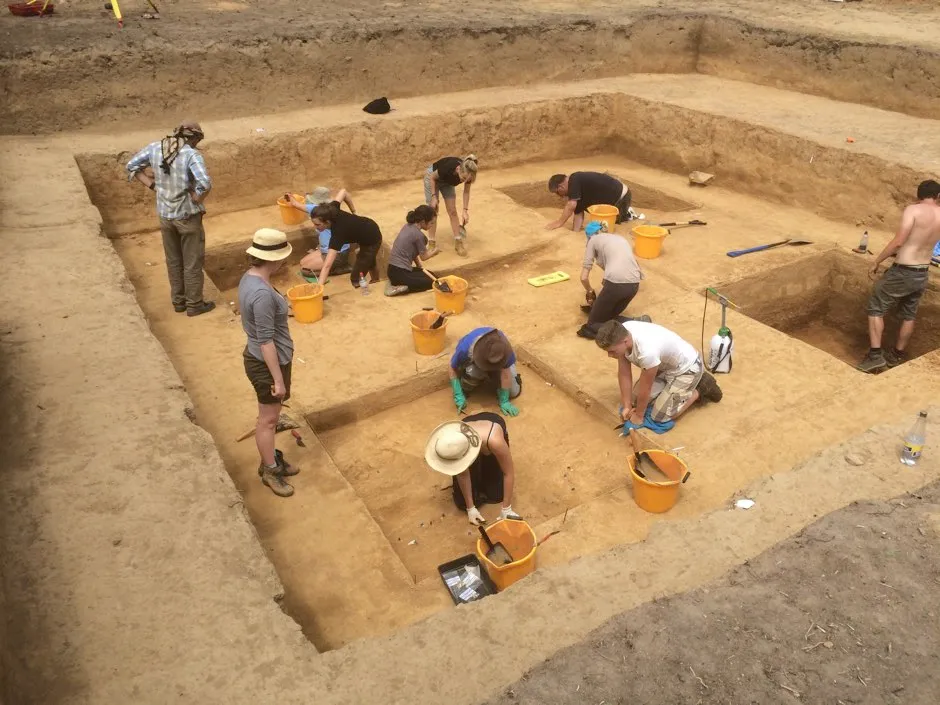Scientists have discovered what they think could be the earliest works of art in the British Isles.
A team of researchers from across the UK have uncovered prehistoric designs on 10 stone fragments, thought to be somewhere between 14,000 and 23,000 years old.
The fragments which are thought to be parts of ornamental tablets, or plaquettes, were found at the Les Varines archaeological site in the south east of Jersey.
The experts believe the abstract engravings were made by the Magdalenians, early hunter-gatherers who lived across Europe towards the end of the most recent Ice Age.
The findings are published in the journal Plos One.
Read more about archaeology:
- Roman city revealed in 'astonishing level of detail' by radar technology
- 48,000-year-old arrowheads found in Sri Lankan cave
- 'DNA fingerprinting' may help to decipher Dead Sea Scrolls
Dr Chantal Conneller, a senior lecturer at Newcastle University and one of the authors on the study, said: “These engraved stone fragments provide exciting and rare evidence of artistic expression at what was the farthest edge of the Magdalenian world.
“The people at Les Varines are likely to have been pioneer colonisers of the region and creating engraved objects at new settlements may have been a way of creating symbolic relationships with new places.”

The Magdalenian era is thought to represent the culmination of cultural development in Europe around 18,000 years ago.
From cave art and tools, weapons and decorations to engravings on animal bones and teeth, examples of Magdalenian art have been found in various parts of western Europe.
Plaquettes made by Magdalenians have also previously been uncovered at sites in France, Spain and Portugal.
While Magdalenian settlements are known to have existed as far as North West Britain, it is the first time artistic stone engravings from this era have been discovered in the British Isles.

The researchers analysed the Les Varines plaquettes, which revealed groups of fine lines that, they believe, were purposefully made using tools made of stones.
The ornamental work also features curved markings, possibly made through repeated incisions.
According to the researchers, the two types of marks may have been created using the same tools, possibly by the same engraver and in short succession.
Read more about art:
- Scientists team up with artist to make the most realistic dinosaur model ever
- Can robots be creative?
- Leonardo da Vinci's forgotten legacy
Lead author Dr Silvia Bello, a researcher at the Natural History Museum in London, said: “Microscopic analysis indicates that many of the lines, including the curved, concentric designs, appear to have been made through layered or repeated incisions, suggesting that it is unlikely that they resulted from the stones being used for a functional purpose.
“The majority of the designs are purely abstract, but others could depict basic forms such as animals, landscapes or people.
“This strongly suggests that the plaquettes at Les Varines were engraved for purposeful artistic decoration.”

The plaquette fragments were found in an area thought to have been used as a hearth, while three of the pieces were recovered from an area of granite slabs which may have served as paving.
Dr Ed Blinkhorn, senior geoarchaeologist at University College London and director of excavations at the site, who is also one of the study authors, said: “The plaquettes were tricky to pick apart from the natural geology at the site – every stone needed turning.
“Their discovery amongst hearths, pits, paving, specialist tools, and thousands of flints shows that creating art was an important part of the Magdalenian pioneer toolkit, as much at camp as within caves.”
Reader Q&A: Why do we have to dig so deep to uncover ancient ruins?
Asked by: Nikkola Furfaro, Australia
There is a survivorship bias at work here: buildings and monuments left exposed on the surface don’t last very long. Humans steal the best bits to reuse in other buildings, and erosion wears everything else to dust. So the only ancient ruins we find are the ones that were buried.
But they got buried in the first place because the ground level of ancient cities tended to steadily rise. Settlements constantly imported food and building materials for the population, but getting rid of waste and rubbish was a much lower priority. New houses were built on top of the ruins of old ones because hauling away rubble was labour intensive and it was much easier to simply spread it out and build straight on top.
Rivers periodically flooded and added a layer of silt, while in dry regions the wind was constantly blowing in sand and dust. (The Sphinx was buried up to its head in sand until archaeologists re-excavated it in 1817.)
When ancient towns were abandoned entirely, plant seeds quickly took root and created more bulk from the CO2 they pulled from the air. Their roots stabilised the soil created from rotting plant matter and the layers gradually built up.
Read more:
